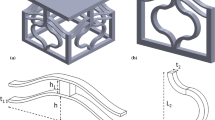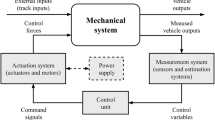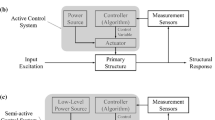Abstract
Purpose
The dynamic cause of rail corrugation in the braking section under multiple vibration inducements is studied by combining the theories of self-excited and feedback vibrations in this article.
Methods
Aiming at the typical rail corrugation in the braking section of high-speed railways, the power/trailer wheel–rail–brake system and the corrugated irregularity are established. Field and numerical analyses are applied to explore the dynamic cause of rail corrugation under multiple vibration inducements.
Results
Results show that the dynamic cause of rail corrugation is comprehensively affected by the self-excited and feedback vibrations of the system.
Conclusion
The friction-induced vibration of the wheel–rail subsystem caused by the coupling of the stick–slip friction is the fundamental genesis of rail corrugation, whereas the rolling-slip self-excited vibration of the braking subsystem exacerbates the rail corrugation in the braking section. For the brake subsystem, the wheel-mounted disc is more likely to intensify the unsteady vibration of the system than the axle-mounted disc. Besides, the increase of the friction coefficient in the braking system aggravates the unsteady vibration of the wheel–rail–brake system. Moreover, as the wave hollow of corrugated irregularity increases, the feedback vibration of the corrugated irregularity induces the aggravation of corrugation. The aggravating trend tends to be linear with the variation of the wave hollow of corrugated wear.









Similar content being viewed by others
References
Zhai W, Jin X, Wen Z et al (2020) Wear problems of high-speed wheel/rail systems: observations, causes, and countermeasures in China. Appl Mech Rev 72(6):060801
Tao G, Zefeng W, Xuesong J et al (2020) Polygonisation of railway wheels: a critical review. Railw Eng Sci 28(3):1–29
Correa N, Oyarzabal O, Vadillo EG et al (2011) Rail corrugation development in high speed lines. Wear 271(9–10):2438–2447
Cui X, Cheng Z, Yang Z et al (2020) Study on the phenomenon of rail corrugation on high-speed rail based on the friction-induced vibration and feedback vibration. Veh Syst Dyn. https://doi.org/10.1080/00423114.2020.1817507
Grassie SL (2012) Rail irregularities, corrugation and acoustic roughness: characteristics, significance and effects of reprofiling. Proc Inst Mech Eng Part F J Rail Rapid Transit 226(F5):542–557
Oostermeijer KH (2008) Review on short pitch rail corrugation studies. Wear 265(9):1231–1237
Sato Y, Matsumoto A, Knothe K (2002) Review on rail corrugation studies. Wear 253(1):130–139
Sun YQ, Simson S (2008) Wagon–track modelling and parametric study on rail corrugation initiation due to wheel stick-slip process on curved track. Wear 265(9):1193–1201
Liu X, Wang P (2020) Investigation of the generation mechanism of rail corrugation based on friction induced torsional vibration. Wear 468–469:203593
Fourie D, Fröhling R, Heyns S (2020) Railhead corrugation resulting from mode-coupling instability in the presence of veering modes. Tribol Int 152(1):106499
Chen GX, Zhou ZR, Ouyang H et al (2010) A finite element study on rail corrugation based on saturated creep force-induced self-excited vibration of a wheelset-track system. J Sound Vib 329(22):4643–4655
Chen GX, Zhang S, Wu BW et al (2020) Field measurement and model prediction of rail corrugation. Proc Inst Mech Eng Part F J Rail Rapid Transit 234(4):381–392
El Beshbichi O, Wan C, Bruni S et al (2020) Complex eigenvalue analysis and parameters analysis to investigate the formation of railhead corrugation in sharp curves. Wear 450–451:203150
Wang Z, Lei Z (2020) Rail corrugation characteristics in small radius curve section of Cologne-egg fasteners. J Mech Sci Technol 34(11):4499–4511
Li W, Wang H, Wen Z et al (2016) An investigation into the mechanism of metro rail corrugation using experimental and theoretical methods. Proc Inst Mech Eng Part F J Rail Rapid Transit 230(4):1025–1039
Xiao H, Yang S, Wang HY et al (2018) Initiation and development of rail corrugation based on track vibration in metro systems. Proc Inst Mech Eng Part F J Rail Rapid Transit 232(9):2228–2243
Yu M, Wang WD, Liu JZ et al (2019) The transient response of high-speed wheel/rail rolling contact on “roaring rails” corrugation. Proc Inst Mech Eng Part F J Rail Rapid Transit 233(10):1068–1080
Wang YR, Wu TX (2020) The growth and mitigation of rail corrugation due to vibrational interference between moving wheels and resilient track. Veh Syst Dyn 58(8):1257–1284
Carlberger A, Torstensson PT, Nielsen JC et al (2018) An iterative methodology for the prediction of dynamic vehicle–track interaction and long-term periodic rail wear. Proc Inst Mech Eng Part F J Rail Rapid Transit 232(6):1718–1730
Baeza L, Vila P, Xie G et al (2011) Prediction of rail corrugation using a rotating flexible wheelset coupled with a flexible track model and a non-Hertzian/non-steady contact model. J Sound Vib 330(18–19):4493–4507
Meehan PA, Bellette PA, Horwood RJ (2014) “Does god play dice with corrugations?”: environmental effects on growth. Wear 314(1–2):254–260
Bao PY, Cui XL, Ding HH, Yin Y, Du ZX, Yang ZC (2022) Influences of friction self-excited vibration characteristics of various types of high-speed trains on rail corrugations in braking sections. Eng Fail Anal 134:106087
TG/GW 115-2012. Regulations for the maintenance of ballastless tracks of high-speed railways
Wu BW, Chen GX, Kang X et al (2020) Study on the origin of rail corrugation at a long downhill braking section based on friction-excited oscillation. Tribol Trans 63(3):439–452
Wu BW, Qiao QF, Chen GX et al (2019) Effect of the unstable vibration of the disc brake system of high-speed trains on wheel polygonalization. Proc Inst Mech Eng Part F J Rail Rapid Transit 234(1):80–95
Lu CX, Jin S (2019) Dynamic response of vehicle and track in long downhill section of high-speed railway under braking condition. Adv Struct Eng 23(3):523–537
Zhao XN, Chen GX, Lv JZ et al (2019) Study on the mechanism for the wheel polygonal wear of high-speed trains in terms of the frictional self-excited vibration theory. Wear 426–427:1820–1827
Ren L, Xie G, Iwnicki S (2012) Properties of wheel/rail longitudinal creep force due to sinusoidal short pitch corrugation on railway rails. Wear 284–285:73–81
Qian WJ, Chen GX, Ouyang H et al (2014) A transient dynamic study of the self-excited vibration of a railway wheel set-track system induced by saturated creep forces. Veh Syst Dyn 52(9):1135–1138
Xiang ZY, Mo JL, Ouyang H et al (2020) Contact behaviour and vibrational response of a high-speed train brake friction block. Tribol Int 152:106540
Nobari A, Ouyang H, Bannister P (2015) Statistics of complex eigenvalues in friction-induced vibration. J Sound Vib 338:169–183
Ciavarella M, Barber J (2008) Influence of longitudinal creepage and wheel inertia on short-pitch corrugation: a resonance-free mechanism to explain the roaring rail phenomenon. Proc Inst Mech Eng Part F J Rail Rapid Transit 222(3):171–181
Wang KY, Liu PF, Zhai WM et al (2015) Wheel/rail dynamic interaction due to excitation of rail corrugation in high-speed railway. Sci China Technol Sci 58(2):226–235
Acknowledgements
The authors are grateful for the field data provided by China Railway Materials General Operation and Maintenance Technology Co., Ltd. The authors thank the financial support from the National Natural Science Foundation of China (51805057), the China Postdoctoral Science Foundation (2019M663889XB), the Chongqing Municipal Education Commission Science and Technology Research Project (KJZD-K202100703), the Chongqing Engineering Laboratory Open Fund for Traffic Engineering Application Robot (CELTEARKFKT-202004), the Research Innovation Foundation Designated for Graduate Students of Chongqing Jiaotong University (CYS21359).
Author information
Authors and Affiliations
Corresponding author
Additional information
Publisher's Note
Springer Nature remains neutral with regard to jurisdictional claims in published maps and institutional affiliations.
Rights and permissions
About this article
Cite this article
Cui, X., Li, T., Bao, P. et al. Research on the Dynamic Cause of Rail Corrugation in the Braking Section of High-Speed Railways Under Multiple Vibration Inducements. J. Vib. Eng. Technol. 11, 71–83 (2023). https://doi.org/10.1007/s42417-022-00559-z
Received:
Revised:
Accepted:
Published:
Issue Date:
DOI: https://doi.org/10.1007/s42417-022-00559-z




